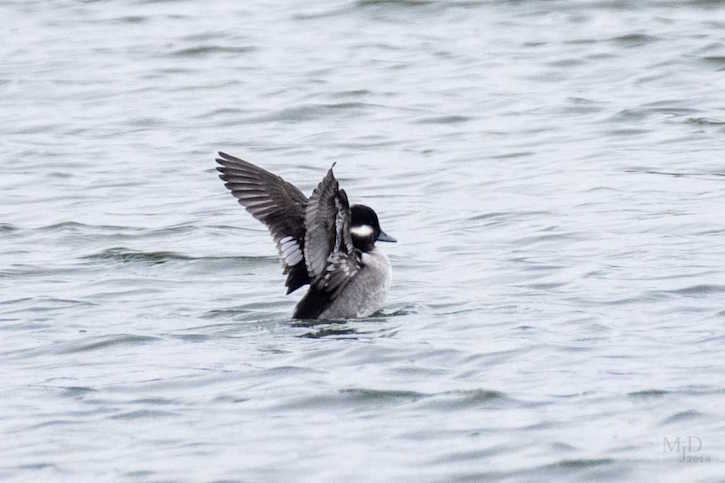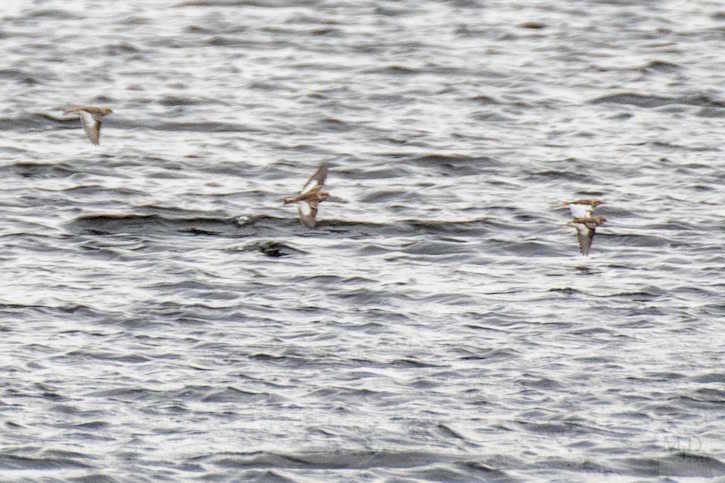Wednesday’s sloppy beginning turned into a fine day to go out with a bunch of loyal (if mildly unruly) birders. It’s duck season, so Dave Weaver and I decided to take the gang over to Cherry Hill Reservoir first. On the way, we stopped at the bridge over the Upper Artichoke Reservoir, where a few forest birds could be heard, and where a raft of Ring-necked Ducks paddled around near one Northern Pintail and some Mallards. At Cherry Hill Reservoir, we rolled up on a small flock of Hooded Mergansers and a Bufflehead. The mergansers flew off to join others, about 50 all told. Ruddy Ducks were scattered over the entire reservoir, and a flock of 100 or so Common Mergansers paraded up and down the lake.

Bufflehead female on Cherry Hill Reservoir – Mike Densmore
A flock of Eastern Bluebirds burst on the scene, landing with a couple of American Goldfinches in nearby trees. A Belted Kingfisher also made his way noisily around the scene, keeping some of us busy trying for photos. Farther down the road along the shore, we found a big flock of Ring-necked Ducks comprising about 60 birds.
This satisfying freshwater survey got us excited to get back out to Plum Island, where we found the ocean off parking lot #1 strewn with loons and grebes. Mostly we found Red-throated Loons, with about three Common Loons mixed in. North of the platform, Red-necked Grebes were all about, in small groups or alone. We didn’t find any eiders, but Long-tailed Ducks and scoters of all three species showed up in pairs or small flocks. A flock of Rock Pigeons flew up the beach, prompting some in our group to try to make them into some other more exotic species. Just because they thrive in cities, however, one should remember what a robust bird the pigeon is, replete with many stunning capacities, especially in the area of navigation and orientation.

Red-throated Loon – Mike Densmore
The Main Panne made for a good stop, with two pairs of Northern Shovelers and another two of Gadwalls, along with the American Black Ducks that will winter with us. A Northern Harrier spent some time over the marsh and pannes just south of us. Just before we left, I spotted an American Bittern as it flew across a stretch of marsh and then disappeared down into it. Neither my shouts nor my gesticulations helped others to find the fleeting thing, however, and the jolly crew decided to cast all kinds of aspersions upon their leader regarding the honesty, clear-headedness, vision, or other faculties I apparently lacked in reporting a desirable bird of which there was no trace. All mockery rolled off my back, though, oiled with the idea that if it were really that bad, it would be too embarrassing for them to joke about, and as far as I was concerned, order was restored.

American Black Ducks – Mike Densmore
Next, we went to use our remaining time in the increasing breeze on Hellcat dike. We were very happily surprised by American Coots on both sides! A number of Buffleheads, a Hooded Merganser, and a Ruddy Duck made it a day of unusual ducks for the refuge impoundments. Northern Pintails flew over a couple of times, and a big flock of Snow Buntings made several dashes across Bill Forward Pool to settle well down the dike south of the tower.

Snow Buntings over Bill Forward Pool – Mike Densmore
We charged out to try to see the Snow Buntings on the ground and look for any other species that might be mixed in with them. Habitually, the buntings took inexplicable flights to and fro, then settled densely in a spot on the dike road. On one of their many forays, four darker birds separated to fly by us, and I suggested how nice it would be if they were Lapland Longspurs. Well, they could have been. They just as easily could have been Horned Larks; no corresponding vocalizations occurred. My “friends” met my conjecture with general derision, however, and the rolling ball of “tease the leader” that I thought I’d stopped was back in play. This was a jolly group of WMB regulars indeed – but we are here to make people who love nature happy, no matter what it takes, right?!
Two Red-tailed Hawks , a Cooper’s Hawk that once again elicited jokes as it was reported solely by me, the driver of the lead van, and a Peregrine Falcon made our ride back to Joppa mildly eventful. With the birds we saw on the way home, we finished up a time of feeling thankful for each other and for the magnificent feathered creatures we celebrate as often as we can. These moments of real joy, brought on by each other’s company, the land and seascapes, and by the birds, mark our lives with meaning. Thanks to all of you who share this passion with us, no matter how near or far – especially when it gets silly!
Our list:
W. Newbury —
Mallard (4) – Upper Artichoke Reservoir.
Northern Pintail (1) – Upper Artichoke Reservoir.
Ring-necked Duck (~ 63) – 13, Upper Artichoke Reservoir.; ~ 50, Cherry Hill Res.
Bufflehead (~ 35) – Cherry Hill Reservoir.
Hooded Merganser (~ 50) – Cherry Hill Reservoir.
Common Merganser (~ 110) – Cherry Hill Reservoir.
Ruddy Duck (~ 40) – Cherry Hill Reservoir.
Ring-billed Gull (8) – Cherry Hill Reservoir.
Herring Gull (5) – Cherry Hill Reservoir.
Mourning Dove (4)
Belted Kingfisher (1) – Cherry Hill Reservoir.
Northern Flicker (2) – Cherry Hill Reservoir.
Pileated Woodpecker (1) – Cherry Hill Reservoir.
Blue Jay (4)
Eastern Bluebird (~ 8) – Cherry Hill Reservoir.
American Robin (1)
Dark-eyed Junco (4)
Northern Cardinal (1) – Cherry Hill Reservoir.
American Goldfinch (2) – Cherry Hill Reservoir.
Plum Island (Parker River NWR) —
Canada Goose – common.
Mute Swan (2) – small pannes.
Gadwall (5) – Main Panne.
American Black Duck – common.
Mallard – a few.
Northern Shoveler (4) – 2 pairs, main panne.
Northern Pintail (6) – Bill Forward Pool.
Surf Scoter (1) – parking lot #1 (one) ocean.
White-winged Scoter (2) – pr., one ocean.
Black Scoter (~ 20) – one ocean (no doubt more further out in ocean).
Long-tailed Duck (~ 25) – one ocean.
Bufflehead (8) – Bill Forward Pool.
Common Goldeneye (2) – one ocean.
Hooded Merganser (1) – male; Bill Forward Pool.
Ruddy Duck (1) – male; North Pool from Hellcat dike.
Red-throated Loon – common, one ocean.
Common Loon (3) – one ocean.
Red-necked Grebe (~ 15) – one ocean.
American Bittern (1) – marsh n. main panne.
Great Blue Heron (2) – hay marsh.
Northern Harrier (2)
Cooper’s Hawk (1) – n. end S-curves.
Red-tailed Hawk (2) – n. end S-curves.
American Coot (7) – 5, Bill Forward Pool; 2, North Pool from Hellcat dike.
Herring Gull – common, one ocean.
Great Black-backed Gull (5) – various.
Rock Pigeon – large flock, n. refuge gate.
Peregrine Falcon (1) – flyby, heading east from PI bridge.
Blue Jay (1) – between parking lot #s 1 & 2.
American Crow (1)
Black-capped Chickadee (2) – Hellcat.
American Robin (2) – Hellcat.
Northern Mockingbird (1) – parking lot #1.
European Starling
Snow Bunting (~ 30) – Bill Forward Pool dike.
Song Sparrow (3) – roadside.
Dark-eyed Junco (3) – roadside.

